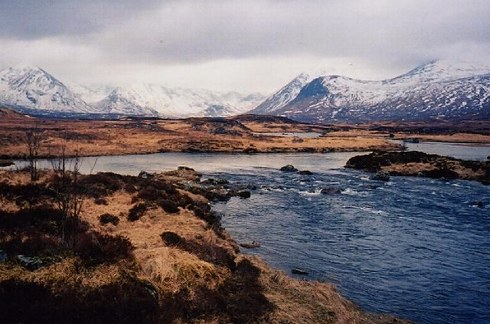Places In Scotland That Are Straight Out Of A Fantasy Novel
Strathaird peninsula, Isle of Skye
This beautiful, barely-populated peninsula in the south of Skye is home to the ruins of the Iron Age hill fort Dun Ringill. Most of the peninsula is now owned by conservation charity The John Muir Trust.
Smoo Cave, Durness
No, this isn’t a series of screenshots from a video game: It’s actually Smoo Cave, a 200 foot long series of interconnected sea caverns near the village of Durness in the highlands.
Knapps Loch, Kilmacolm, Inverclyde
Knapps Loch is a small but impossibly scenic loch beside the village of Kilmacolm, which has been occupied since the Bronze Age and sits 16 miles west of Glasgow.
The Fairy Pools, Isle of Skye
Glen Coe, Highland
This sweeping, dramatic, and precipitous glen was carved from the surrounding landscape by glaciers during the last ice age. It’s generally considered to be one of the most spectacular places in Scotland.
Dunottar Castle, Aberdeenshire
This Game Of Thrones style fortress is actually Dunnottar – from the Scottish Gaelic Dùn Fhoithear, which means “fort on the shelving slope”. The site is thought to have been occupied since Pictish times (5000 BC to 700 AD).
Buachaille Etive Mòr, Highland
The “Great Herdsman of Etive” dominates the skyline for miles around and can easily be seen from the scenic A82 road. The name actually refers to a ridge rather than an individual mountain: Its most recognisable peak is Stob Dearg (pictured).
Handa Island, Sutherland
The sandstone cliffs surrounding this stunning, wildlife-packed west coast island come alive every summer when around 100,000 seabirds gather to breed, including over 250 pairs of puffin.
Kilchurn Castle, Loch Awe
Kilchurn Castle is a ruined 15th century fortress that sits at the north eastern end of Loch Awe in Argyll. It was the ancestral home of Clan Campbell, but was abandoned after being badly damaged by lightning in 1760.
Callanish Standing Stones, Isle of Lewis
These ominous standing stones on the Isle of Lewis are arranged in a cruciform shape. According to legend, early on midsummer morning an entity known as the “Shining One” walks through the stones to the centre of the circle.
Rannoch Moor, Perth and Kinross
This 50 square mile expanse of moorland – also known as the Great Moor of Rannoch – is home to a vast array of wildlife, including grouse, curlews and red deer.
For More Read :Buzz Feed
Strathaird peninsula, Isle of Skye
This beautiful, barely-populated peninsula in the south of Skye is home to the ruins of the Iron Age hill fort Dun Ringill. Most of the peninsula is now owned by conservation charity The John Muir Trust.
Smoo Cave, Durness
No, this isn’t a series of screenshots from a video game: It’s actually Smoo Cave, a 200 foot long series of interconnected sea caverns near the village of Durness in the highlands.
Knapps Loch, Kilmacolm, Inverclyde
Knapps Loch is a small but impossibly scenic loch beside the village of Kilmacolm, which has been occupied since the Bronze Age and sits 16 miles west of Glasgow.
The Fairy Pools, Isle of Skye
Glen Coe, Highland
This sweeping, dramatic, and precipitous glen was carved from the surrounding landscape by glaciers during the last ice age. It’s generally considered to be one of the most spectacular places in Scotland.
Dunottar Castle, Aberdeenshire
This Game Of Thrones style fortress is actually Dunnottar – from the Scottish Gaelic Dùn Fhoithear, which means “fort on the shelving slope”. The site is thought to have been occupied since Pictish times (5000 BC to 700 AD).
Buachaille Etive Mòr, Highland
The “Great Herdsman of Etive” dominates the skyline for miles around and can easily be seen from the scenic A82 road. The name actually refers to a ridge rather than an individual mountain: Its most recognisable peak is Stob Dearg (pictured).
Handa Island, Sutherland
The sandstone cliffs surrounding this stunning, wildlife-packed west coast island come alive every summer when around 100,000 seabirds gather to breed, including over 250 pairs of puffin.
Kilchurn Castle, Loch Awe
Kilchurn Castle is a ruined 15th century fortress that sits at the north eastern end of Loch Awe in Argyll. It was the ancestral home of Clan Campbell, but was abandoned after being badly damaged by lightning in 1760.
Callanish Standing Stones, Isle of Lewis
These ominous standing stones on the Isle of Lewis are arranged in a cruciform shape. According to legend, early on midsummer morning an entity known as the “Shining One” walks through the stones to the centre of the circle.
Rannoch Moor, Perth and Kinross
This 50 square mile expanse of moorland – also known as the Great Moor of Rannoch – is home to a vast array of wildlife, including grouse, curlews and red deer.
For More Read :Buzz Feed





























0 comments:
Post a Comment